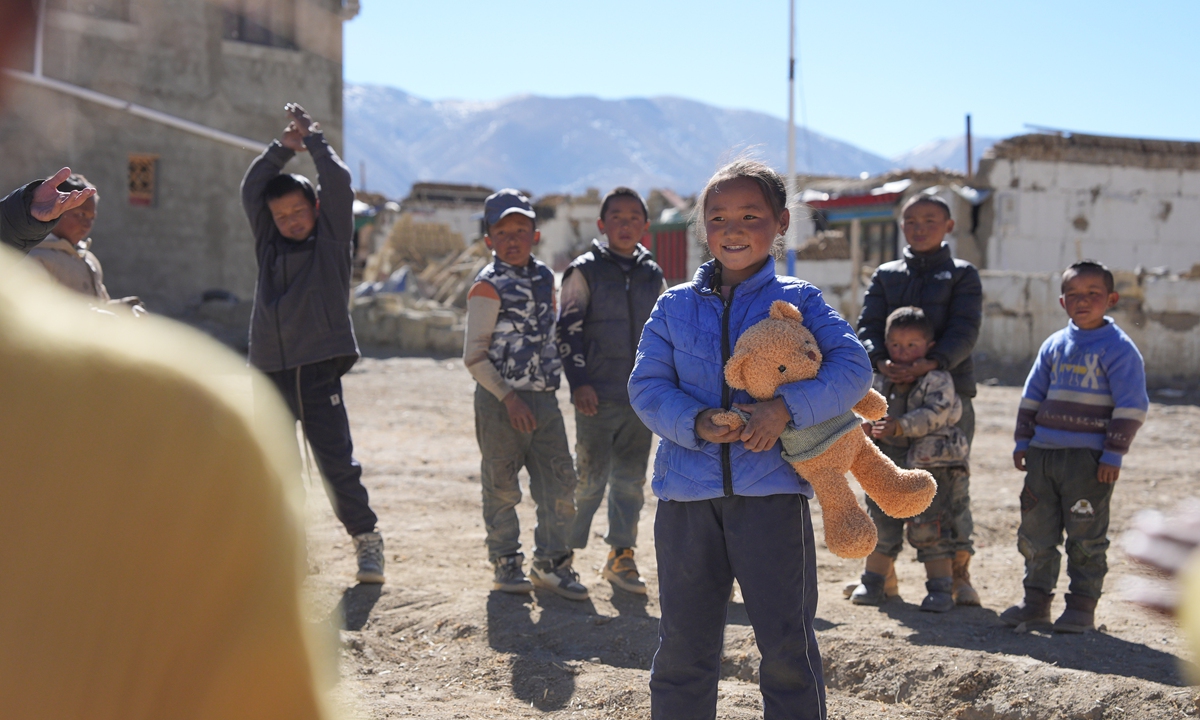What should the West see from rescue efforts in Xizang earthquake?: Global Times editorial
Listen

A social worker presents toy to children in a resettlement site in a village of Dingri county, Xigaze, in southwest China's Xizang Autonomous Region on January 8, 2025. Photo: Xinhua
The 6.8 magnitude earthquake in Dingri county, Xigaze, Southwest China's Xizang Autonomous Region, is tugging at the hearts of all Chinese people and garnered widespread attention from the international community. International figures, including UN Secretary-General Antonio Guterres, Russian President Vladimir Putin, French President Emmanuel Macron, Serbian President Aleksandar Vucic, and Japanese Prime Minister Shigeru Ishiba, have extended their condolences to China. At present, the rescue work has shifted to the resettlement of victims and post-disaster reconstruction. They are still being carried out in a tense yet orderly manner, with help from both domestic and international social forces continuously flowing into the disaster area, offering a humanitarian glimpse of compassion in the face of such an unfortunate disaster.
This earthquake has attracted significant international attention, not only due to humanitarian reasons but also because it occurred in Xizang - a multi-ethnic region often targeted by some in the West with so-called human rights issues. Observing the rescue and reconstruction efforts in the wake of this earthquake will provide valuable insights into what has happened in Xizang over the years and the actual human rights situation there. Dingri county, located at the foot of Mount Qomolangma, commonly known in the West as Mount Everest, "roof of the world," has an average elevation of about 5,000 meters. A series of factors, including the harsh winter, high altitude, and remote location, make rescue operations particularly challenging. However, just 10 minutes after the earthquake struck, rescue helicopters were already in the sky. Within less than half an hour, teams had begun to clear debris in the earthquake's epicenter. Personnel, including emergency rescuers, firefighters, forest fire, police and military officers, arrived in a couple of hours. Within less than a day, local networks, roads, and power supplies were gradually restored, and most affected residents were sheltered in warm tents or prefab houses, with hot three meals a day.
Anyone without prejudice toward Xizang can easily draw several conclusions from this. First, the fast and orderly rescue efforts demonstrate that Xizang's level of emergency response mechanism construction has significantly improved, which reflects the rapid progress in Xizang's infrastructure.
Second, the prompt relief provided to local residents after the disaster indicates that Xizang's material conditions have reached a considerable standard.
Third, during the earthquake relief efforts, countless volunteers, rescue workers, and local residents demonstrated a spirit of unity, mutual assistance, and selfless dedication. The solidarity between Han, Tibetan and other ethnic groups, with no distinctions between them, highlights the rock-solid foundation of ethnic unity in Xizang and the strong grassroots identification with community for the Chinese nation. This is the true essence of Xizang.
The speed and efficiency of the disaster relief efforts in Dingri county are rarely seen on a global scale. This is the result of the central government and the entire nation's long-standing care and support for Xizang, providing substantial assistance in manpower, resources, finances, technology, and policies over the years.
Without decades of consistent investment, if Xizang were still in its historically isolated state - marked by treacherous transportation, arduous travel, and reliance on human and animal labor for goods transport - it is unimaginable what kind of devastation such a sudden natural disaster could have caused.
Xizang has undergone a dramatic transformation, evolving from extreme backwardness to modernization.
Although Dingri county is located on the southwestern border, its development has always been closely connected to the lifeline of the entire nation. Ideally, we hope disasters will never be needed to prove Xizang's progress - and in fact, they are entirely unnecessary. Simply visiting Xizang and experiencing it firsthand reveals that Xizang is an indispensable part of a people-centered national development effort.
Previously, Bishnu Pukar Shrestha, the Nepalese ambassador to China, in an interview with this publication, expressed admiration for Xizang's modernization.
He said the significant investment in infrastructure and the realization of interconnectivity between highland cities offer valuable lessons for countries like Nepal.
This time, while a natural disaster has torn a wound into the snowy plateau, the entire nation is working tirelessly to heal it. And the motherland serves as a steadfast source of comfort and support for every individual affected by the disaster. This is the best interpretation of human rights.
On Chinese social media platforms, the topic "protecting and helping Xigaze" has been trending, reflecting the collective voice and actions of the entire nation. For frontline rescue workers, there are still tough battles ahead, and post-disaster reconstruction will require constant effort.
We have every reason to believe that everything will get better in the region and the expectation is highly consistent in Chinese society. However, the "Western human rights lens" that some have tried to impose on Xizang will inevitably be torn apart by the facts and ultimately collapse completely.



